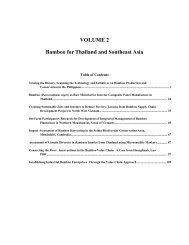WBC-VIII-Vol.4 – Resources – Forestry, Plantations and ... - BambuSC
WBC-VIII-Vol.4 – Resources – Forestry, Plantations and ... - BambuSC
WBC-VIII-Vol.4 – Resources – Forestry, Plantations and ... - BambuSC
You also want an ePaper? Increase the reach of your titles
YUMPU automatically turns print PDFs into web optimized ePapers that Google loves.
hectares; bamboo (both natural <strong>and</strong> planted) occupies around 11.4 million hectares. This represents 16.7 percent<br />
of the total forest area of the country <strong>and</strong> 3.4 percent of the total geographical are (329 million hectares) of India<br />
(FSI 2003). Bamboo constitutes important species occurring widely in the Indian forests <strong>and</strong> forms the understorey<br />
in the natural forests. It is found to grow practically all over the country, particularly in the tropical, subtropical<br />
<strong>and</strong> temperate regions where the annual rainfall ranges between 1,200 mm to 4,000 mm <strong>and</strong> the<br />
temperature varies between 16 o C <strong>and</strong> 38 o C. The most suitable conditions for the occurrence of bamboo are<br />
found in between 770-1,080 meter above sea level. However, two-thirds of the growing stock of bamboo in the<br />
country is available in the north-eastern states. Bamboo forms a part of a wide variety of forest types in Indian<br />
forests. It may constitute a separate forest type or sub-type or occur as brakes. The forest types/sub types in<br />
India are listed in Table 1 (Champion <strong>and</strong> Seth 1968).<br />
Table 1. Distribution of Bamboo in different Forest types<br />
S.N. Forest Type No. Forest type/Sub type Dominant Species<br />
1.<br />
2.<br />
3.<br />
4.<br />
5.<br />
6.<br />
7.<br />
1/E2<br />
2/E2<br />
3/E2<br />
3/2S1<br />
5/E9<br />
8/E1<br />
12/DS1<br />
West Bamboo Brakes<br />
West Bamboo Brakes<br />
Moist Bamboo Brakes<br />
Dry Bamboo Brakes<br />
Dry Bamboo Brakes<br />
Reed Brakes<br />
Montane Bamboo Brakes<br />
Ochl<strong>and</strong>ra sp, Bambusa sp.<br />
Ochl<strong>and</strong>ra sp, Bambusa sp.<br />
Bambusa bambos,<br />
Schizostachyum kurzii.<br />
Dendrocalamus strictus.<br />
Dendrocalamus strictus.<br />
Ochl<strong>and</strong>ra sp.<br />
Sinarundinaria sp.<br />
There are 124 indigenous <strong>and</strong> exotic species under 23 genera, found naturally <strong>and</strong>/or under cultivation (Naithani<br />
1993). Clump forming bamboo constitute over 67% of the total growing stock, of which Dendrocalamus strictus<br />
is 45%, Bambusa bambos 13%, D. hamiltonii 7%, B. tulda 5% <strong>and</strong> B. pallida 4%. All other species put together<br />
are 6%. Melocanna baccifera, a non-clump forming bamboo, accounts for 20% of the growing stock <strong>and</strong> is<br />
found in the north-eastern states of India. Bamboo falls into two main categories according to growth pattern, (i)<br />
sympodial or clump forming, (ii) monopodial or non-clump forming, runner bamboo. North-east India supports<br />
about 50% of the total genetic resources followed by peninsular India ( Eastern & Western Ghats), which<br />
accounts for about 23% of the genetic resources occurring naturally. North-western India, Indo-Gangetic plains<br />
<strong>and</strong> the Andaman & Nicobar Isl<strong>and</strong>s account for the remaining bamboo diversity in India.<br />
Bamboo today is a major non-wood forest product <strong>and</strong> wood substitute <strong>and</strong> also important from socioeconomic<br />
& cultural point of view. Quickly changing its image from the “poor man’s tree” to a high-tech industrial raw<br />
material <strong>and</strong> wood substitute, bamboo is globally recognized now as an increasingly important economic asset<br />
in poverty eradication <strong>and</strong> economic & environmental development. Bamboo has always played an important<br />
economic <strong>and</strong> cultural role across Asia <strong>and</strong> its usage is growing rapidly in Latin America <strong>and</strong> Africa as well.<br />
Since the beginning of civilization bamboo has played an important part in daily lives of people in India.<br />
Bamboo craft is one of the oldest cottage industries primarily due to versatility, strength, lightness, easy<br />
<strong>VIII</strong> World Bamboo Congress Proceedings Vol 4-16




